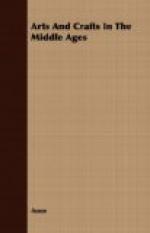In France were many specimens of the mosaics of the fifth century. But literary descriptions are all that have survived of these works, which might once have been seen at Nantes, Tours, and Clermont.
[Illustration: MOSAIC FROM RAVENNA; THEODORA AND HER SUITE, 16TH CENTURY]
Ravenna is the shrine of the craft in the fifth and sixth centuries. It is useless in so small a space to attempt to describe or do justice to these incomparable walls, where gleam the marvellous procession of white robed virgins, and where glitters the royal cortege of Justinian and Theodora. The acme of the art was reached when these mural decorations were planned and executed, and the churches of Ravenna may be considered the central museum of the world for a study of mosaic.
Among those who worked at Ravenna a few names have descended. These craftsmen were, Cuserius, Paulus, Janus, Statius and Stephanus, but their histories are vague. Theodoric also brought some mosaic artists from Rome to work in Ravenna, which fact accounts for a Latin influence discernible in these mosaics, which are in many instances free from Byzantine stiffness. The details of the textiles in the great mosaics of Justinian and Theodora are rarely beautiful. The chlamys with which Justinian is garbed is covered with circular interlaces with birds in them; on the border of the Empress’s robe are embroideries of the three Magi presenting their gifts; on one of the robes of the attendants there is a pattern of ducks swimming, while another is ornamented with leaves of a five-pointed form.
There is a mosaic in the Tomb of Galla Placida in Ravenna, representing St. Lawrence, cheerfully approaching his gridiron, with the Cross and an open book encumbering his hands, while in a convenient corner stands a little piece of furniture resembling a meat-safe, containing the Four Gospels. The saint is walking briskly, and is fully draped; the gridiron is of the proportions of a cot bedstead, and has a raging fire beneath it,—a gruesome suggestion of the martyrdom.
No finer examples of the art of the colourist in mosaic can be seen than in the procession of Virgins at San Apollinaire Nuovo in Ravenna. Cool, restrained, and satisfying, the composition has all the elements of chromatic perfection. In the golden background occasional dots of light and dark brown serve to deepen the tone into a slightly bronze colour. The effect is especially scintillating and rich, more like hammered gold than a flat sheet. The colours in the trees are dark and light green, while the Virgins, in brown robes, with white draperies over them, are relieved with little touches of gold. The whole tone being thus green and russet, with purplish lines about the halos, is an unusual colour-scheme, and can hardly carry such conviction in a description as when it is seen.
In the East, the Church of Sta. Sophia at Constantinople exhibited the most magnificent specimens of this work; the building was constructed under Constantine, by the architects Anthemius and Isidore, and the entire interior, walls and dome included, was covered by mosaic pictures.




